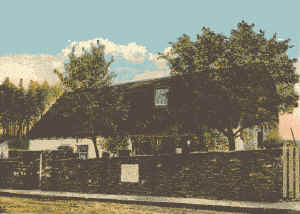Old
CHESTER
in Delaware County, PA
OldChesterPa.com: Caleb Pusey House
On the
web since March 2000!
Always check our
"What's
New" page
Have you signed our Guest Book at "The Newsstand"?
![]()
A project of the National Heritage Foundation
What is this Foundation?
I'd
like to make a donation to help support this website!
Home >
FEATURED PICTURE

Would you like to sponsor this page?
|
Contacting me: - Update I
have temporarily cleared a small amount of space in my email box.
However, spam continues to be a problem. To be sure you get through the
filters, be sure to include the name of our city somewhere either
in the subject or the body of your email. Sponsor |
SEARCH the website - Thousands of pages of Chester History!
Caleb Pusey House,
Upland, PA
By Professor Mitchell Rothman, Widener University, Chester, PA
 The
Caleb Pusey House is the oldest continuously standing house in
southeastern Pennsylvania. It was built in 1683 and last occupied in
1950. Its story is in many ways the story of southeastern
Pennsylvania. Caleb Pusey (his real last name was Bartholomew) was a
lastmaker (a person who makes wooden foot molds for cobblers) in England,
a Quaker, and a close friend of William Penn.
The
Caleb Pusey House is the oldest continuously standing house in
southeastern Pennsylvania. It was built in 1683 and last occupied in
1950. Its story is in many ways the story of southeastern
Pennsylvania. Caleb Pusey (his real last name was Bartholomew) was a
lastmaker (a person who makes wooden foot molds for cobblers) in England,
a Quaker, and a close friend of William Penn.
After Penn acquired his holdings in Pennsylvania, he had his land divided
into parcels to be sold to the First Purchasers. These were Quakers
and other Protestants from England, France, and Holland, who
wanted to escape old Europe and start over in the New World. Penn
realized that his First Purchasers would need to have lumber and a grist
mill to grind their grain. He asked his friend, Caleb Pusey, to
construct and run such a mill on the Landingford Plantation in what is now
Upland along the Chester Creek. A prefabricated mill was loaded as
ballast in the hull of the ship Welcome, bound for landing at Marcus Hook.
Pusey, his wife Anne Worley, and their two daughters by her first
marriage, sailed on the Welcome, and upon landing trucked the mill through
the woods to the Landingford Plantation in the Fall of 1682. With
winter coming on, the Puseys dug a pit house on their plot, and lived
there the first winter (Anne lost the child she was carrying). In
the Spring of 1683, Caleb built the first part of the house that still
bears his name.
Pusey built and operated the mills (the first was swept away in a flood)
in the Enlightenment community of Landingford Plantation until 1717, when
he moved with his family, who would include a daughter who was the fore
bearer of the artist Maxwell Parish, to East Marlborough Township.
Pusey was the first magistrate of Delaware County and a jack-of-all-trades
in these earliest days.
The house and mills changed hands a number of times after Pusey left, the
longest period (1792-1845) by Flower family. In 1845, they sold the
mill and lands to John Price
Crozer, one of the industrial barons of the
Christian Revitalist movement. Crozer saw Pusey's house as a symbol
of the beginning of industry in America. He therefore built a wall
around the house and installed the African-American midwife of the
community, Mother Jones (nor the famous one), whose family lived in it for
the next 60 years. Crozer built his weaving mill around the bend of
the Chester Creek to produce a famous blue woolen cloth, which he sold to
his great profit, to the Union Army in the Civil War. He also built
the First Baptist Church of Upland,
a schoolhouse to teach the children of his mill workers to read the Bible
and much of the housing stock of Upland.
The house passed through many hands after the Crozers left Upland.
In the 1950's, a group of Quaker women lead by Josephine Albrecht, began a
project to strip away the house's many remodelings, so that it would
come as close as possible to the original. In the process, she and
neighbor people (unfortunately without the advice of a professional
archaeologist) excavated one million artifacts, mostly of the
Revolutionary Period, which are stored on the second floor of the Crozer
Schoolhouse.
Tours of the house are available on weekends through the Friends of the
Caleb Pusey House, Inc.